|
|
Celestron C14 EdgeHD Optical Analysis-Phase
2 Testing with OTA Thermal Modifications
Wade Van Arsdale
Little Rock, AR., USA
July 25th, 2011
For earlier testing without thermal modifications installed, see this link.
|
|
(Shown above with AstroZap Aluminum Dewshield)
Synopsis:
This round of tests (and also the earlier testing) used an initial front-fan cooldown of 30 minutes through the Fastar cell with a high-CFM filtered fan (see below for parts list). Without initial front-fan cooling, none of the earlier Roddier tests produced Strehl values any better than mid to upper 80's, even after up to two hours of passive cool-down prior to testing. There is a significant and consistent improvement in wavefront quality by using an initial front-fan prior to observing or imaging. For this 2nd round of tests, internal felt flocking and dual rear constant-on fans were added to see if the initial thermal equilibrium gained from the front fan could be *maintained* for a longer period. Despite much better results in this round of tests, it is inconclusive at this point on these latest mods since the OTA was recollimated afterward and the air mass is different now from the 1st round of tests last year. These factors could be what produced the better results this time. The next round of tests to come in the next month will hopefully give the answer to whether these latest two mods are effective or not.
I. 2nd Phase of Optical Tests:
Strehl and Wavefront Error Testing
Objectives: Determine how
much the Strehl results could be improved by flocking the OTA to insulate its
aluminum surface better, and from a semi-permanent rear fan installation to move
ambient air into the OTA.
Problem: The aluminum tube cools much faster than the OTA glass. It was determined through repeated visual, webcam, and Roddier testing that this severe imbalance in cooling efficiency between the two materials creates thermal air currents and boundary layers *inside* the OTA that degrade the wavefront quality similar to poor atmospheric seeing conditions. Previous testing proved conclusively that using front-fan forced cooling of the OTA prior to testing consistently brought the OTA to thermal equilibrium and significantly stabilized the star-test patterns. But unfortunately, it was found that these thermals and boundary layers on the front side of the primary mirror glass and up the baffle tube would regenerate to a point that planetary performance was seriously degraded within approximately 15-20 minutes after the front fan was removed and secondary mirror was reinserted back into the OTA. This effect was found to be present even on very slow delta-T nights. The two passive back-end factory vents were of little or no value in alleviating these effects. Also, on the EdgeHD models, the baffle tube is sealed by a permanent corrector lens set, so there is no way to use a Lymax Cat Cooler or other method to easily bring it back to equilibrium through the rear end baffle tube. So a way was needed to lessen the difference in cooling rates between the aluminum tube surface and primary mirror glass so the thermals and boundary layers could be lessened and wavefront quality improved.
Thermal Fixes Used For
Phase 2 Testing:
A combination of three remedies was used:
1) Felt
flocking from
Protostar was applied inside the entire OTA surface. This flocking was
used as a way to help insulate the inside aluminum tube surface and slow down
its cooling rate to more closely match the cooling rate of the mirror
glass. It was hoped that this would lessen the
amount of internal thermals and boundary layer regeneration inside the OTA after
initial thermal equilibrium was reached with the temporary front fan.
**NOTE**: removing the front corrector glass to install flocking may void
your factory warranty from Celestron. **DO NOT** attempt this modification
unless you have weighed the ramifications and are willing to take the warranty
risks and you have also carefully considered the risks of breaking the front
corrector glass or being unable to return the OTA to its original collimation
and corrector positioning on the front cell.
2) A homemade high-CFM filtered front fan assembly was used in the Fastar housing for 30 minutes prior to running the Roddier tests. Since the OTA cannot be used while the front fan is in place, this is only a temporary fan that is used to bring about *initial* OTA equilibrium.
3) A semi-permanent, "constant-on" rear fan solution was installed on the top factory
passive vent assembly using two 30mm low-vibration fans. This was done to help move
outside air into the tube to reduce the difference between the air temp inside
the OTA and the ambient outside air temp. The thinking there was if the
temp differential between internal
OTA air and glass surfaces could be brought closer together, the thermals and
boundary layer regeneration could be lessened to improve wavefront accuracy. This is
not an optimal solution however. The most effective solution would be to
install rear fans with larger capacity that pull outside air in through the *entire* OTA from the front and out
the back. By moving air down the baffle tube and across the front surface
of the OTA, this would break up the thermals and boundary layer
much more effectively than using a fan system that just moves air in and out the
back-end without going through the entire length of the OTA. However, to
install such a fan solution would require drilling holes into the front section
of the OTA tube as well as the rear primary mirror cell. This runs the risk of ruining the telescope's resale
value and would certainly
void the factory warranty. The fan installation that was ultimately used, while
less effective at moving air through the entire OTA, has the advantages of being
removable, very low-profile, and non-destructive to any part of the OTA.
Strehl Test and Roddier Analysis
Test Date: June 25th, 2011
OTA Tested: 2010 Celestron C14 EdgeHD
Test Sequence:
1) Remove front corrector glass and install felt flocking internally.
2) Install two 30mm low-vibration fans on top factory vent assembly at
rear of OTA.
3) Re-install corrector and re-collimate using MetaGuide
Software.
4) Remove secondary mirror and install temporary 60mm high-CFM front fan into Fastar
cell for initial OTA cooling.
5) Run temporary front fan for 30 minutes prior to beginning test imaging.
6) Remove temporary front fan, reinsert secondary mirror back into Fastar cell, and begin imaging.
Test Site: C.A.A.S. East Observatory, Little Rock, AR., el. 650 ft.
Skies: Clear
Seeing: 9 out of 10
Transparency: 7 out of 10
Temperature: 86 degrees F, dropping to 84 degrees F during OTA testing
Dewpoint: 72 degrees
Wind: S, 5 mph
Test camera: Lumenera SKYnyx 2-2C webcam with Baader IR/UV cutoff filter @
640 x 480 image size, 26 fps capture rate for 1000 frames, and resolution
of 0.23 arc-sec/pixel, @ native focal length of 3910mm
Reference
Chart for Strehl Values and P-V Wavefront Errors. Chart courtesy of R.F.
Royce Precision Optical Components:
|
Commonly Encountered Wavefront Relationships |
||||
| P-V Fraction | P-V Decimal | Marechal RMS* | Strehl Ratio | Comments |
| 1/3 | .333 | .094 | .71 | |
| 1/4 | .250 | .071 | .82 | Rayleigh Limit |
| 1/5 | .200 | .057 | .88 | |
| 1/6 | .167 | .047 | .92 | Good |
| 1/7 | .143 | .041 | .94 | Very Good |
| 1/8 | .125 | .036 | .95 | Excellent |
| 1/9 | .111 | .032 | .960 (.96) | Excellent |
| 1/10 | .100 | .028 | .969 (.97) | Excellent |
| 1/11 | .091 | .026 | .974 | |
| 1/12 | .024 | .024 | .978 | "Super Apo" |
Strehl
Test Results: **NOTE**
The OTA was recollimated using the MetaGuide
software after the initial Roddier testing showed that a slight
miscollimation was present. Due to this re-collimation and differences in
atmospheric seeing between two widely varying test dates and air masses, it
cannot be deduced from the below tests how much if any the thermal modifications had on
improving the OTA's Strehl results. The Strehl results were significantly
better on this latter phase of testing. However, it is not possible to determine how
much of this improvement was due to better collimation, better atmospherics,
more stable delta-T's, or forced fan cooling. The webcam display of the star pattern was *significantly* stabilized
by using the front fan for 30 minutes prior to commencing both the earlier test
runs and these most current tests.
However, it remains to be seen how long the insulating flocking and rear fan modifications cause this OTA equilibrium to be
*maintained*. This will have to be tested further to determine the
image stability with vs. without the thermal modifications.
| GREEN
(reference): Strehl Test for mid-bandwidth reference (Green--approx. 550nm wavelength) Summary: The Strehl tested at an excellent 0.970, which corresponds to 1/10th wave accuracy, which is outstanding. The glass is almost perfectly corrected in the Green bandwidth. The RMS value of Lambda/36.2 indicates very smooth glass figure overall. The PTV value of Lambda/7.0 indicates the worst single error on the glass surface is very small and does not hurt performance in any significant way. 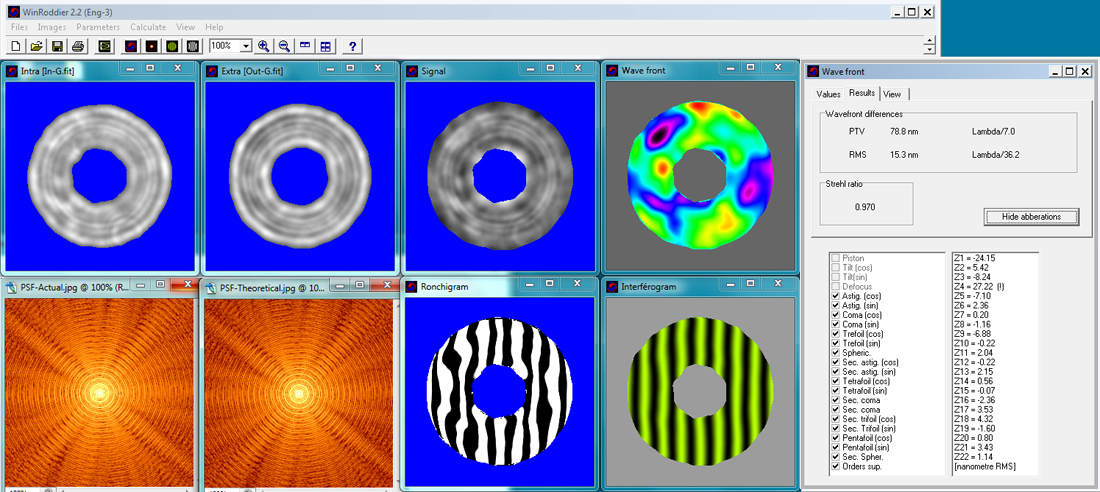
|
| RED: The glass is slightly undercorrected in the Red bandwith, but still with a good Strehl value of 0.918, which corresponds to a P-V wavefront error of slightly worse than 1/6th wave. The undercorrection in Red will tend to correct itself slightly as the glass temp cools and the glass reaches thermal equilibrium with the outside air. 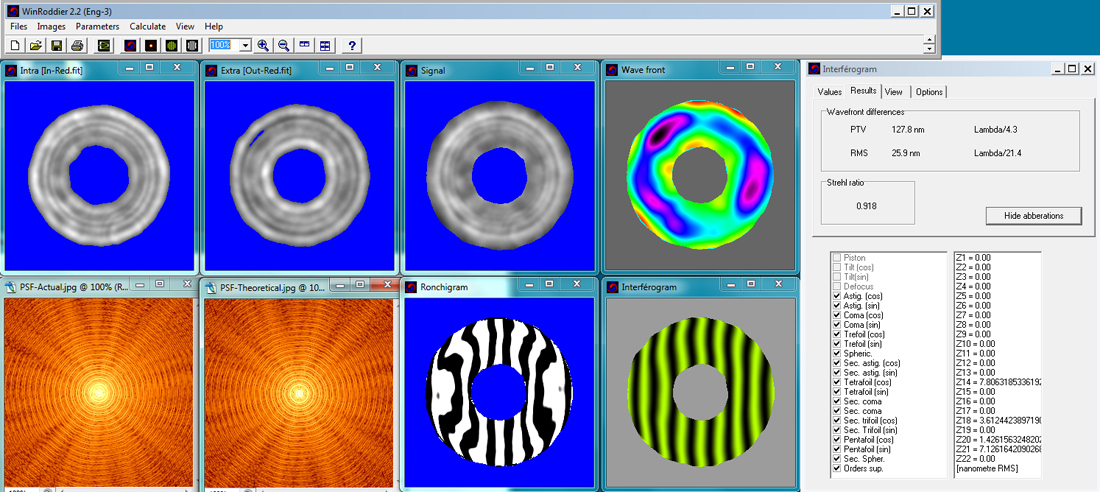
|
| BLUE: The scope tested out as about equal wavefront quality in the Blue bandwidth vs. the Red bandwith, but worse than the Green bandwidth. Blue bandwidth Strehl was 0.914, which is just under 1/6th wave. The telescope is slightly overcorrected in Blue. This overcorrection in Blue will be the primary weakness in the OTA's performance because it will not fix itself as the glass cools further and may even get slightly worse. But this problem will go mostly unnoticed for visual work since the human eye is relatively insensitive to the far-Blue bandwidth. It could be a factor though for CCD imaging and hurt sharp star focus slightly, especially with one-shot color CCD cameras and color DSLR's. But the effects of it should be very minor for photography overall, especially for mono cameras where refocusing is done with each color filter change. The scope overall has very good glass figure and should be a very good performer for both visual astronomy and CCD imaging. 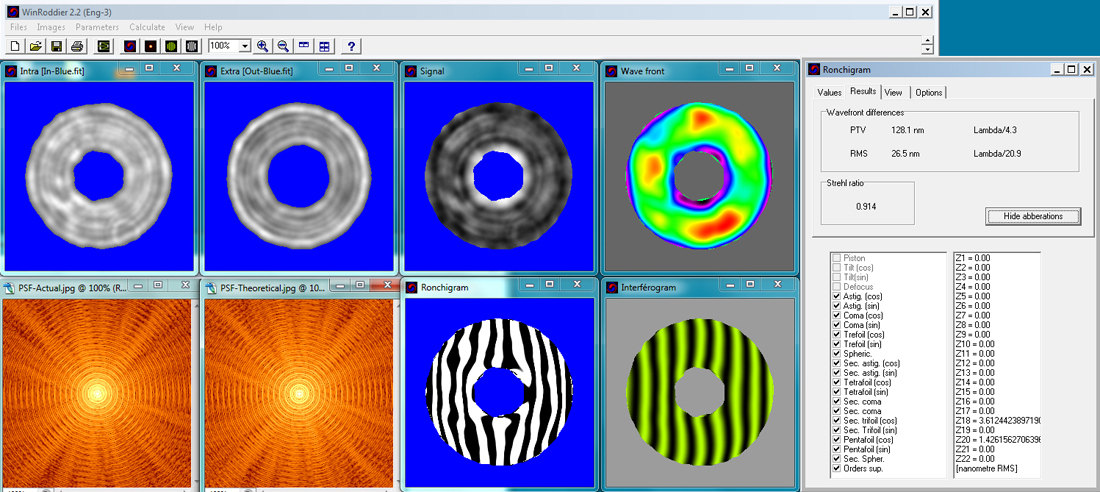
|
| POLYCHROMATIC
(entire Red, Green, and Blue wavelength data present in test images): As expected, due to the undercorrection in Red and overcorrection in Blue, the full-color Strehl is adversely affected compared to the Green wavelengths, but the OTA still tests out to a very good poly-Strehl of 0.931. In real-life use this telescope exhibits excellent performance as a visual planetary and deep-sky instrument once it has reached thermal equilibrium, with very sharp focus and excellent resolution of low-contrast planetary details. The overall wavelength accuracy over the entire color spectrum is still very good and the performance of the telescope verifies this. 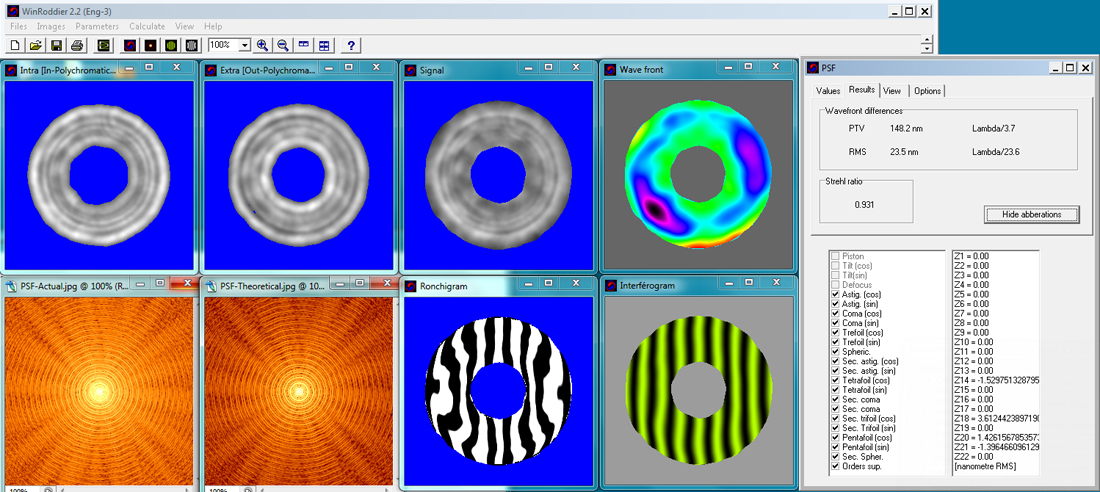 |
II. Zernike Polynomials:
In this section, we examine the optical
alignment, astigmatism, collimation, and spherochromatic aberration of the
optics. The star used for the test (Arcturus) was at a sky altitude of more than
70 degrees to help insure least possible interference in the results from
atmospheric effects and blue extinction. Green was used as the reference
bandwidth for these Zernike comparisons.
Strehl
with all optical figure and alignment defects included: 0.970
Strehl, or 1/10th wave.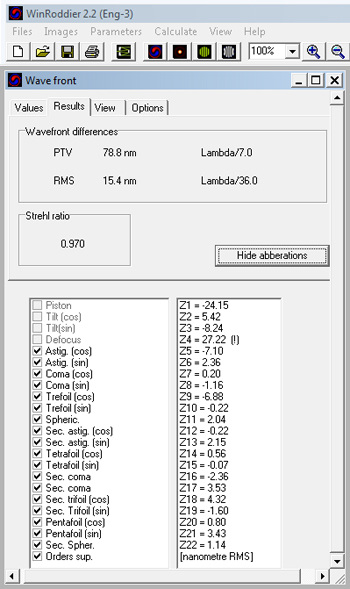 |
Strehl
with Coma removed from the measurements: 0.970 Strehl,
or an excellent 1/10th wave.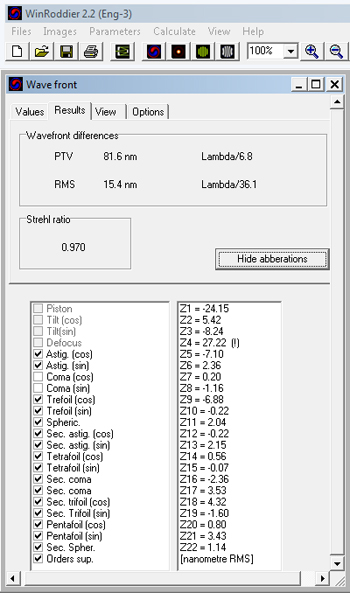 This result indicates the telescope is in perfect collimation. I highly recommend MetaGuide software as a very effective tool to achieve perfect collimation when atmospheric seeing is good. The lack of coma in the test results also indicates that secondary-to-primary mirror axial centering is basically perfect in this sample. |
Strehl
with Astigmatism removed from the calculations: An outstanding 0.977 Strehl,
or 1/12th wave.
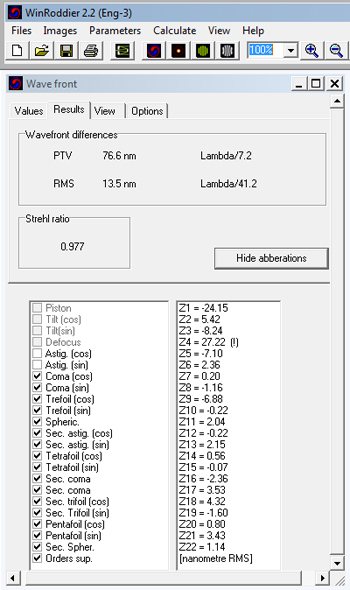 Astigmatism is likely due to slight tip-tilt error of primary mirror in relation to the secondary mirror. This error could be compensated for by basic collimation, but still be present in the wavefront analysis. Astigmatism could be caused by the typical SCT primary mirror "flop" causing some tip/tilt error in the primary mirror. Some slight astigmatism may be coming from the glass figure as well, or from residual temperature imbalance in the glass surface. Also, it was found that the corrector plate centering pins were tightly pressing on the edge of the corrector glass, which may need to be alleviated in the future if the OTA is torn down again. This could be a possible source of the astigmatism. Moving the centering pins could de-center the factory secondary mirror positioning in relation to the primary, so it was decided not to alter the pins at this time since astigmatism is still low in this sample. |
| Strehl
with Spherical Aberration removed: 0.971 Strehl, or 1/10th wave. 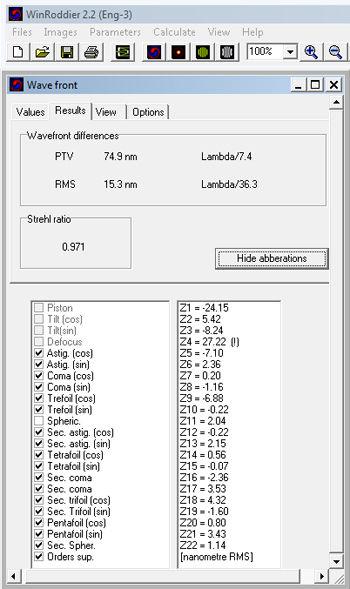 The telescope shows almost no detectable SA, indicating excellent glass figure and corrector glass accuracy. However, the polychromatic SA is slightly worse on this sample due to the slightly miscorrected Red and Blue wavelengths. Polychromatic Strehl on this OTA is 0.931, which is still outstanding for full-color results. |
Strehl
with all major alignment defects removed: 0.977
Strehl, or 1/12th wave.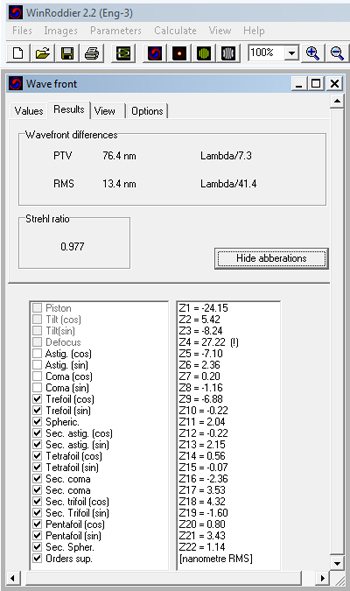 Overall, the glass quality on this unit is outstanding. Most of the wavefront error is likely due to atmospheric seeing, tip-tilt error from mirror flop, residual temperature flux in the mirror, and some possible slight mis-figuring of the glass surface itself during manufacture (all are potential sources of astigmatism). |
III. Conclusions:
Roddier/Optical Analysis
Summary:
The
C14 EdgeHD tested out as outstanding after front-fan cooling, with a Strehl value of 0.970, as measured
mid-bandwidth in the Green (approximately 550 nm wavelength). This
corresponds to a wavefront error of approximately 1/10th wave glass
accuracy. The RMS result of Lambda/36.2 indicates a very smooth glass
surface with excellent glass figuring and polishing techniques used during manufacture. The
PTV result of Lambda/7.0 indicates the single worst glass-figure error is very
small, and does not significantly affect the overall performance of the
telescope. The Strehl value for this OTA's final wavefront accuracy once
central obstruction effects are calculated is approximately 0.78, which is very
close to 1/4th wave (diffraction-limited). 0.78 true wavefront Strehl at
focal point is very good for a telescope of this design and central obstruction size.
t
This
OTA shows almost no detectable spherochromatic aberration, which indicates the
front corrector plate is of excellent quality and is positioned accurately at
the factory for maximum performance. This was also verified in the webcam
and visual star-testing, with the in and out-focused images showing very little
difference between each other in appearance. The telescope is very
neutrally corrected in the Green wavelengths and less corrected
in the Blue and Red bandwidths. There is some slight residual
astigmatism seen in the test results. This could be due to tip/tilt error
caused by primary mirror flop. In this design, even with the factory
mirror-locking system in use, the flop error is only cut approximately in half
(as measured in earlier testing using CCDI
software to analyze the mirror flop). It is impossible with this
focusing mechanism and design to cut a moving
mirror's flop error all the way to zero.
The telescope tested out at 0.918 Strehl in the Red bandwidth and 0.914 Strehl in Blue. The glass is slightly undercorrected in the Red wavelengths and slightly overcorrected in the Blue bandwidth. This condition should self-correct slightly in the Red wavelengths as the glass continues to come to equilibrium with the outside air temperature. But the glass will not correct in the Blue wavelengths, and may get slightly worse as glass cooling continues though the night. Forced fan cooling from the front prior to observing with full flow through the OTA and out the back will also help the undercorrection in the Red wavelengths. The telescope is best-corrected in the Green wavelengths, which is the most important bandwidth for visual astronomy. The visual testing so far has confirmed the Roddier results, with the telescope showing excellent focus sharpness and resolution of fine contrast and detail on planetary visual observations when the OTA has been force-cooled to ambient temp and atmospheric seeing is good.
Thermal Analysis:
**EFFECTS
OF FORCED-FAN COOLING AND INTERNAL OTA INSULATION WITH FELT FLOCKING**:
Due to recollimation after the earlier
testing and widely differing test dates and air masses between the two test
cycles, it is impossible to determine how much, if any improvement was caused in
the OTA's performance due to the modifications described on this webpage.
The results are significantly better now though, vs. the earlier testing from
last fall. The initial front forced fan cooling does cause a significant
and consistent improvement in image stability as observed on repeated tests
using a webcam with in and out-focused star patterns. However, more testing is needed to
determine if the internal felt flocking and constant-on rear fans will have a beneficial longer-term thermal effect
on the OTA during the night. It remains to be seen if these modifications
will prevent or at least slow down interior
thermal and boundary layer regeneration as the metal's outside surface cools,
especially on higher delta-T nights. If the flocking and rear fans can maintain similar performance to
what was seen immediately after removing the front fan, this OTA can be made
into an outstanding instrument for serious planetary use.
A final note about Celestron's claims that removing the secondary mirror assembly from the Fastar cell and reinserting it does not affect collimation: analysis of star-test patterns after several removal/reinsertion cycles did verify that on this OTA, their claim is true. I could not find any variation in collimation over several test cycles. So this makes front-end forced fan cooling much more feasible as a way to bring the OTA to proper equilibrium prior to observing. One must be extremely careful though in removing and reinserting the secondary assembly. It is very easy to have an accident with the assembly and drop it, especially in the dark or with cold fingers handling the assembly. So this factor should be carefully considered.
In my
opinion it is very clear that this OTA will
basically *never* reach an acceptable level of thermal equilibrium for serious
planetary observations without
user-intervention and some type of forced cooling solution combined with
enhanced aluminum OTA surface insulation. For those not wanting to
disassemble the OTA to flock it internally, wrapping the outside of the OTA with
some type of insulating material like lightweight foam would still help it
thermally. While the telescope is usable
for deep-sky observations without any modifications, my experiences with repeated
testing of this OTA clearly indicate that it cannot be made to perform as a
serious planetary instrument without forced cooling. In the earlier tests
without flocking or any fan intervention, even after up to two hours of passive cool-down,
the OTA did not achieve any better than mid to upper 80 Strehl values.
However, *with* forced front-fan cooling, the scope gives outstanding planetary results
(at least temporarily), on
a par with any telescope I have ever used of a compound mirror
design. Further testing will be needed to determine if the rear fans and
felt flocking thermal modifications are effective. Also, **SEE DISCLAIMER BELOW**.
IV: Fan and Felt Flocking Pictures With Parts List for Modifications:
Rear Fan Parts List (click links to view detailed information about parts. All fan hardware is removable from OTA and installed without making any permanent alterations to OTA):
1) Two Adda
12V DC Low-Vibration 30mm fans (attached to factory vent screen on top of
OTA using thin strips of Super Velcro. The fans are so lightweight this is
all that has been required and is working well with no issues). The Super
Velcro strips provide good enough shock absorption from the fans that no
vibration was seen in the eyepiece at high powers up to 488x during the visual
star-testing.
2) One pack of Mouser
30 ppi filter media (cut to fit: replaces metal 60ppi filter screen
inside both factory vents. 60ppi filter does not allow for enough air flow
with the Adda fans).
3) One standard 4 wire phone cable (can substitute 2-wire since the fans are 2-wire
design....Radio Shack, etc..... Used to connect fan wires to telephone
cable and telephone cable to bottom 4-pin power connector).
4) Various wire connectors (any local hardware or Radio Shack store)
5) One standard 4-wire computer motherboard connector with male pins (use 2-wire
connector if available locally...only two wires are needed so you can snip two
of them if you have to use a 4-wire plug).
6) One 4-wire female computer motherboard connection extender plug (wired to fans using
4-wire phone cable routed through factory vents on back of OTA with 2 of the
wires snipped since they are not needed). This is
the plug visible at bottom of OTA in above photo.)
7) One Radio
Shack 12V DC, 1.5 Amp power supply (end of cable snipped and re-wired to
4-pin male connector plug)
8) One sheet of adhesive Protostar
felt flocking for interior of OTA (used for aluminum surface insulation to
slow cooling of metal surface to more closely match primary mirror glass cooling
rates and reduce tube
thermals).
Front Fan Parts List:
1) Plastic 10.5 oz. Folgers
coffee can lid
2) Orion
High-CFM 60mm fan
3) Mouser
Electronics 60mm, 30 ppi filter media assembly
4) One pack of 1 inch width Super Velcro (cut to fit and use on inside lip of plastic
coffee can lid if needed to tighten up fit of lid on Fastar cell)
(To power front fan, use same Radioshack power supply described above. Then unplug supply and remove front fan after 30 minutes of cooling, reinsert secondary mirror, plug power supply into rear fan connector and begin observing).
(An inline On/Off toggle switch and second power supply could easily be added to the rear fan setup if desired to avoid having to plug and unplug connector on bottom of OTA to power supply).
V: Future Testing:
1) Differential
Roddier and visual tests are still needed to determine if the flocking insulation and constant-on
rear fans will *maintain* the thermal equilibrium long-term throughout the night
that is achieved by use of the initial front fan cooling. I hope to
complete this next round of testing sometime in the next 4 to 6 weeks.
A note about the Roddier software used to measure Strehl in these tests: the Roddier software does an analysis of the *glass quality*, not the final wavefront quality. It does *not* include the central obstruction effects in the final Strehl ratios it calculates from the test images. For a compound mirror-obstructed telescope, the true wavefront Strehl at focal point can be calculated using this formula (from the book Suitor's "Star Testing Astronomical Telescopes":
Corrected Strehl Ratio = (Telescope’s measured Strehl Ratio) x [(1-c^2)^2
c = central obstruction percentage of telescope’s primary mirror aperture by secondary mirror housing
For example, according to the above formula, this C14 sample would have a real wavefront Strehl of approximately 0.78 after including the central obstruction effects on the wavefront, or slightly below 1/4th wave (slightly less than diffraction-limited in real wavefront performance at the eyepiece/CCD camera). 0.78 is an excellent result for a compound-mirror telescope with a central obstruction of 32%. This is verified with the actual visual and webcam performance of the OTA which is excellent once the telescope is brought to thermal equilibrium.
** UPDATE ON FANS
AND THERMALS** 9/14/2011:
The
"push-only" rear fan setup shown above DID NOT WORK as well as NO rear
fans. After several On-Off test cycles, it was determined the rear fans
pushing air into the tube are actually DESTABILIZING the wavefront quality at
the focal plane. This may be because the air injected into the rear-end of
the OTA is not being routed. The turbulence may be making it to the front
surface of the primary glass. This would not be a smooth laminar flow, so
that may be where the problem lies.
For the next round of tests, I will install "PULL-ONLY" fans at one rear vent. This will pull air in at the other rear vent and route it back out through the fan on the other side of the tube. Hopefully this will route the airflow better and prevent non-laminar turbulence from reaching the front side of the primary mirror glass. More results will be posted when I have the data all collected. The assumption there is that this will help pull any residual heat out of the center core and back edges of the primary mirror glass that the initial front-fanning did not get, as well as help stop any new temp-differential thermals from re-forming inside the tube on the front side of the glass and baffle tube.
FLOCKING: with the ProtoStar felt flocking installed inside the OTA, I am seeing persistent stabilization of the wavefront with visual testing at the eyepiece and on-screen displays. Once the OTA is stabilized with the high-flow front fan for one hour prior to observing, it *stays* stabilized for up to three hours (the end of the test cycles that I ran). So the felt flocking does appear to be successful in blunting the bare aluminum's effects on creating new tube thermals.
Poor atmospherics and heat-induced building thermals have prevented more Roddier analysis of the OTA, but I hope to have new data as soon as the atmospherics cooperate and ambient temps and the thermals cool down.
More testing to come soon on the "pull-only" rear fan setup......
***DISCLAIMER***
I am not responsible for any damage you do
to your telescope from attempting to make the modifications described
here. If you decide to modify your own telescope, you do so at your OWN
risk to the OTA and the factory warranty. Also, it is important to keep in
mind that no two telescopes, even of the same model, are exactly the same in
build or performance, especially mass-produced SCT's like the instrument described here. So your test results might vary widely from my
results. Likewise, one's ability to disassemble, reassemble, and
re-adjust the OTA to maximum performance will vary from user to
user. Therefore, I make no claims or guarantees that your
telescope's performance will be improved by making any of the modifications to
it that are described here.
Wade Van Arsdale
July 26th, 2011
Little Rock, AR., USA